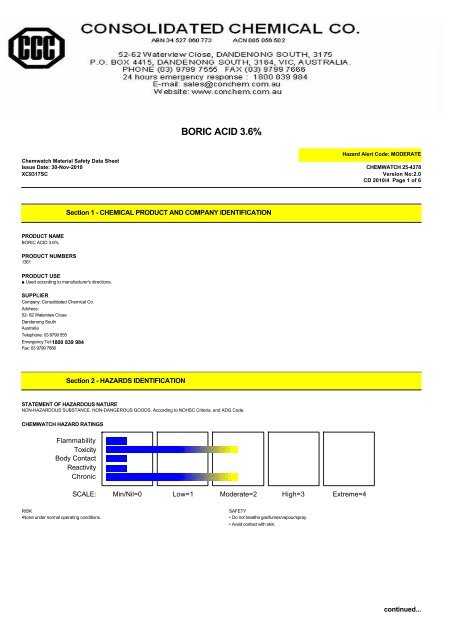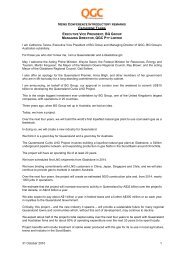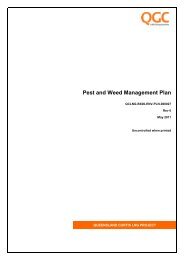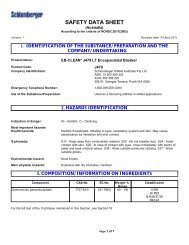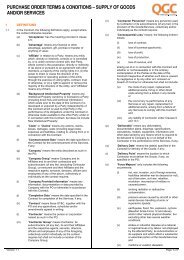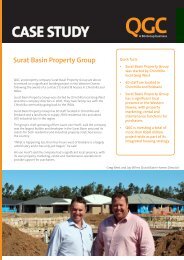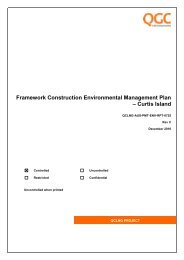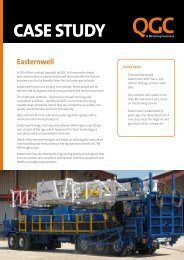Boric Acid 3.6% - QGC
Boric Acid 3.6% - QGC
Boric Acid 3.6% - QGC
You also want an ePaper? Increase the reach of your titles
YUMPU automatically turns print PDFs into web optimized ePapers that Google loves.
BORIC ACID <strong>3.6%</strong><br />
Hazard Alert Code: MODERATE<br />
Chemwatch Material Safety Data Sheet<br />
Issue Date: 30-Nov-2010 CHEMWATCH 25-4378<br />
XC9317SC<br />
Version No:2.0<br />
CD 2010/4 Page 1 of 6<br />
Section 1 - CHEMICAL PRODUCT AND COMPANY IDENTIFICATION<br />
PRODUCT NAME<br />
BORIC ACID <strong>3.6%</strong><br />
PRODUCT NUMBERS<br />
1361<br />
PRODUCT USE<br />
■ Used according to manufacturer's directions.<br />
SUPPLIER<br />
Company: Consolidated Chemical Co<br />
Address:<br />
52- 62 Waterview Close<br />
Dandenong South<br />
Australia<br />
Telephone: 03 9799 555<br />
Emergency Tel:1800 839 984<br />
Fax: 03 9799 7666<br />
Section 2 - HAZARDS IDENTIFICATION<br />
STATEMENT OF HAZARDOUS NATURE<br />
NON-HAZARDOUS SUBSTANCE. NON-DANGEROUS GOODS. According to NOHSC Criteria, and ADG Code.<br />
CHEMWATCH HAZARD RATINGS<br />
Flammability<br />
Toxicity<br />
Body Contact<br />
Reactivity<br />
Chronic<br />
SCALE: Min/Nil=0 Low=1 Moderate=2 High=3 Extreme=4<br />
RISK<br />
•None under normal operating conditions.<br />
SAFETY<br />
• Do not breathe gas/fumes/vapour/spray.<br />
• Avoid contact with skin.<br />
continued...
BORIC ACID <strong>3.6%</strong><br />
Hazard Alert Code: MODERATE<br />
Chemwatch Material Safety Data Sheet<br />
Issue Date: 30-Nov-2010 CHEMWATCH 25-4378<br />
XC9317SC<br />
Version No:2.0<br />
CD 2010/4 Page 2 of 6<br />
Section 3 - COMPOSITION / INFORMATION ON INGREDIENTS<br />
NAME CAS RN %<br />
boric acid 10043-35-3 3.6<br />
water 7732-18-5 >80<br />
Section 4 - FIRST AID MEASURES<br />
SWALLOWED<br />
• If swallowed do NOT induce vomiting.<br />
• If vomiting occurs, lean patient forward or place on left side (head-down position, if possible) to maintain open airway and prevent aspiration.<br />
• Observe the patient carefully.<br />
• Never give liquid to a person showing signs of being sleepy or with reduced awareness; i.e. becoming unconscious.<br />
EYE<br />
■ If this product comes in contact with the eyes:<br />
• Wash out immediately with fresh running water.<br />
• Ensure complete irrigation of the eye by keeping eyelids apart and away from eye and moving the eyelids by occasionally lifting the upper and lower<br />
lids.<br />
• Seek medical attention without delay; if pain persists or recurs seek medical attention.<br />
• Removal of contact lenses after an eye injury should only be undertaken by skilled personnel.<br />
SKIN<br />
■ If skin or hair contact occurs:<br />
• Flush skin and hair with running water (and soap if available).<br />
• Seek medical attention in event of irritation.<br />
INHALED<br />
• If fumes or combustion products are inhaled remove from contaminated area.<br />
• Other measures are usually unnecessary.<br />
NOTES TO PHYSICIAN<br />
■ Treat symptomatically.<br />
Section 5 - FIRE FIGHTING MEASURES<br />
EXTINGUISHING MEDIA<br />
• There is no restriction on the type of extinguisher which may be used.<br />
• Use extinguishing media suitable for surrounding area.<br />
FIRE FIGHTING<br />
• Alert Fire Brigade and tell them location and nature of hazard.<br />
• Wear breathing apparatus plus protective gloves for fire only.<br />
• Prevent, by any means available, spillage from entering drains or water courses.<br />
• Use fire fighting procedures suitable for surrounding area.<br />
FIRE/EXPLOSION HAZARD<br />
• Non combustible.<br />
• Not considered a significant fire risk, however containers may burn.<br />
May emit poisonous fumes.<br />
FIRE INCOMPATIBILITY<br />
■ None known.<br />
HAZCHEM<br />
None<br />
PERSONAL PROTECTION<br />
Glasses: Gloves: Respirator:<br />
Chemical goggles. 1.NEOPRENE 2.VITON 3.BUTYL Particulate<br />
continued...
BORIC ACID <strong>3.6%</strong><br />
Hazard Alert Code: MODERATE<br />
Chemwatch Material Safety Data Sheet<br />
Issue Date: 30-Nov-2010 CHEMWATCH 25-4378<br />
XC9317SC<br />
Version No:2.0<br />
CD 2010/4 Page 3 of 6<br />
Section 6 - ACCIDENTAL RELEASE MEASURES<br />
MINOR SPILLS<br />
• Clean up all spills immediately.<br />
• Avoid breathing vapours and contact with skin and eyes.<br />
• Control personal contact by using protective equipment.<br />
• Contain and absorb spill with sand, earth, inert material or vermiculite.<br />
MAJOR SPILLS<br />
■ Moderate hazard.<br />
• Clear area of personnel and move upwind.<br />
• Alert Fire Brigade and tell them location and nature of hazard.<br />
• Wear breathing apparatus plus protective gloves.<br />
• Prevent, by any means available, spillage from entering drains or water course.<br />
Personal Protective Equipment advice is contained in Section 8 of the MSDS.<br />
Section 7 - HANDLING AND STORAGE<br />
PROCEDURE FOR HANDLING<br />
• Avoid all personal contact, including inhalation.<br />
• Wear protective clothing when risk of exposure occurs.<br />
• Use in a well-ventilated area.<br />
• Prevent concentration in hollows and sumps.<br />
SUITABLE CONTAINER<br />
• Polyethylene or polypropylene container.<br />
• Packing as recommended by manufacturer.<br />
• Check all containers are clearly labelled and free from leaks.<br />
STORAGE INCOMPATIBILITY<br />
■ None known.<br />
STORAGE REQUIREMENTS<br />
• Store in original containers.<br />
• Keep containers securely sealed.<br />
• Store in a cool, dry, well-ventilated area.<br />
• Store away from incompatible materials and foodstuff containers.<br />
Section 8 - EXPOSURE CONTROLS / PERSONAL PROTECTION<br />
EXPOSURE CONTROLS<br />
The following materials had no OELs on our records<br />
• boric acid: CAS:10043- 35- 3 CAS:11113- 50- 1 CAS:41685- 84- 1<br />
• water: CAS:7732- 18- 5<br />
PERSONAL PROTECTION<br />
RESPIRATOR<br />
Particulate<br />
EYE<br />
• Safety glasses with side shields<br />
• Chemical goggles.<br />
• Contact lenses may pose a special hazard; soft contact lenses may absorb and concentrate irritants. A written policy document, describing the<br />
wearing of lens or restrictions on use, should be created for each workplace or task. This should include a review of lens absorption and<br />
adsorption for the class of chemicals in use and an account of injury experience. Medical and first-aid personnel should be trained in their<br />
removal and suitable equipment should be readily available. In the event of chemical exposure, begin eye irrigation immediately and remove contact<br />
lens as soon as practicable. Lens should be removed at the first signs of eye redness or irritation - lens should be removed in a clean environment<br />
continued...
BORIC ACID <strong>3.6%</strong><br />
Hazard Alert Code: MODERATE<br />
Chemwatch Material Safety Data Sheet<br />
Issue Date: 30-Nov-2010 CHEMWATCH 25-4378<br />
XC9317SC<br />
Version No:2.0<br />
CD 2010/4 Page 4 of 6<br />
Section 8 - EXPOSURE CONTROLS / PERSONAL PROTECTION<br />
only after workers have washed hands thoroughly. [CDC NIOSH Current Intelligence Bulletin 59].<br />
HANDS/FEET<br />
■ Suitability and durability of glove type is dependent on usage. Important factors in the selection of gloves include: such as:<br />
• frequency and duration of contact,<br />
• chemical resistance of glove material,<br />
• glove thickness and<br />
• dexterity.<br />
• Wear chemical protective gloves, eg. PVC.<br />
• Wear safety footwear or safety gumboots, eg. Rubber.<br />
OTHER<br />
• Overalls.<br />
• P.V.C. apron.<br />
• Barrier cream.<br />
• Skin cleansing cream.<br />
ENGINEERING CONTROLS<br />
■ General exhaust is adequate under normal operating conditions. If risk of overexposure exists, wear SAA approved respirator.<br />
Section 9 - PHYSICAL AND CHEMICAL PROPERTIES<br />
APPEARANCE<br />
Clear odourless liquid; mixes with water.<br />
PHYSICAL PROPERTIES<br />
Liquid.<br />
Mixes with water.<br />
State Liquid Molecular Weight Not Applicable<br />
Melting Range (°C) Not Available Viscosity Not Available<br />
Boiling Range (°C) Not Available Solubility in water (g/L) Miscible<br />
Flash Point (°C) Not Applicable pH (1% solution) Not Available<br />
Decomposition Temp (°C) Not Available pH (as supplied) Not Available<br />
Autoignition Temp (°C) Not Applicable Vapour Pressure (kPa) Not Available<br />
Upper Explosive Limit (%) Not Applicable Specific Gravity (water=1) Not Available<br />
Lower Explosive Limit (%) Not Applicable Relative Vapour Density Not Available<br />
Volatile Component (%vol) Not Available Evaporation Rate Not Available<br />
(air=1)<br />
Section 10 - STABILITY AND REACTIVITY<br />
CONDITIONS CONTRIBUTING TO INSTABILITY<br />
• Presence of incompatible materials.<br />
• Product is considered stable.<br />
• Hazardous polymerisation will not occur.<br />
For incompatible materials - refer to Section 7 - Handling and Storage.<br />
Section 11 - TOXICOLOGICAL INFORMATION<br />
POTENTIAL HEALTH EFFECTS<br />
ACUTE HEALTH EFFECTS<br />
■ Ingestion may produce health damage*.<br />
■ * (limited evidence).<br />
CHRONIC HEALTH EFFECTS<br />
■ Cumulative effects may result following exposure*.<br />
■ * (limited evidence).<br />
TOXICITY AND IRRITATION<br />
■ Not available. Refer to individual constituents.<br />
continued...
BORIC ACID <strong>3.6%</strong><br />
Hazard Alert Code: MODERATE<br />
Chemwatch Material Safety Data Sheet<br />
Issue Date: 30-Nov-2010 CHEMWATCH 25-4378<br />
XC9317SC<br />
Version No:2.0<br />
CD 2010/4 Page 5 of 6<br />
Section 12 - ECOLOGICAL INFORMATION<br />
No data<br />
Ecotoxicity<br />
Ingredient Persistence: Persistence: Air Bioaccumulation Mobility<br />
Water/Soil<br />
boric acid LOW LOW HIGH<br />
Section 13 - DISPOSAL CONSIDERATIONS<br />
■ Legislation addressing waste disposal requirements may differ by country, state and/ or territory. Each user must refer to laws operating in their<br />
area.<br />
A Hierarchy of Controls seems to be common - the user should investigate:<br />
• Reduction.<br />
• DO NOT allow wash water from cleaning or process equipment to enter drains.<br />
• It may be necessary to collect all wash water for treatment before disposal.<br />
• In all cases disposal to sewer may be subject to local laws and regulations and these should be considered first.<br />
• Where in doubt contact the responsible authority.<br />
• Recycle wherever possible.<br />
• Consult manufacturer for recycling options or consult local or regional waste management authority for disposal if no suitable treatment or<br />
disposal facility can be identified.<br />
• Dispose of by: burial in a land-fill specifically licenced to accept chemical and / or pharmaceutical wastes or incineration in a licenced<br />
apparatus (after admixture with suitable combustible material).<br />
• Decontaminate empty containers. Observe all label safeguards until containers are cleaned and destroyed.<br />
Section 14 - TRANSPORTATION INFORMATION<br />
HAZCHEM:<br />
None (ADG7)<br />
NOT REGULATED FOR TRANSPORT OF DANGEROUS GOODS: UN, IATA, IMDG<br />
Section 15 - REGULATORY INFORMATION<br />
POISONS SCHEDULE S5<br />
REGULATIONS<br />
Regulations for ingredients<br />
boric acid (CAS: 10043-35-3,11113-50-1,41685-84-1) is found on the following regulatory lists;<br />
"Australia Hazardous Substances","Australia High Volume Industrial Chemical List (HVICL)","Australia Inventory of Chemical Substances (AICS)",<br />
"Australia Standard for the Uniform Scheduling of Medicines and Poisons (SUSMP) - Appendix E (Part 2)","Australia Standard for the Uniform Scheduling<br />
of Medicines and Poisons (SUSMP) - Schedule 5","Australia Therapeutic Goods Administration (TGA) Substances that may be used as active ingredients in<br />
Listed medicines","China Inventory of Existing Chemical Substances","GESAMP/EHS Composite List - GESAMP Hazard Profiles","Japan Chemical Substances<br />
Control Law - Existing/New Chemical Substances","Japan GHS Classifications (Japanese)","Korea (South) Existing Chemicals List (KECL)","New Zealand<br />
Hazardous Substances and New Organisms (HSNO) Act - Chemicals (single components)","New Zealand Hazardous Substances and New Organisms (HSNO) Act -<br />
Classification of Chemicals","New Zealand Hazardous Substances and New Organisms (HSNO) Act - Classification of Chemicals - Classification Data","New<br />
Zealand Hazardous Substances and New Organisms (HSNO) Act - Pesticides","New Zealand Hazardous Substances and New Organisms (HSNO) Act - Timber<br />
Preservatives, Antisapstains and Antifouling Paints","New Zealand Hazardous Substances and New Organisms (HSNO) Act - Veterinary Medicines","New<br />
Zealand Inventory of Chemicals (NZIoC)","OECD Representative List of High Production Volume (HPV) Chemicals","Philippines Inventory of Chemicals and<br />
Chemical Substances (PICCS)","Singapore Environmental Protection and Management (Hazardous Substances) Regulations","Singapore Environmental<br />
Protection and Management Act (EPMA) - List of Controlled Hazardous Substances","Singapore Poisons List"<br />
water (CAS: 7732-18-5) is found on the following regulatory lists;<br />
"Australia Inventory of Chemical Substances (AICS)","China Inventory of Existing Chemical Substances","IMO IBC Code Chapter 18: List of products to<br />
which the Code does not apply","International Fragrance Association (IFRA) Survey: Transparency List","Korea (South) Existing Chemicals List (KECL)",<br />
"New Zealand Inventory of Chemicals (NZIoC)","OECD Representative List of High Production Volume (HPV) Chemicals","Philippines Inventory of Chemicals<br />
and Chemical Substances (PICCS)"<br />
No data for <strong>Boric</strong> <strong>Acid</strong> <strong>3.6%</strong> (CW: 25-4378)<br />
continued...
BORIC ACID <strong>3.6%</strong><br />
Hazard Alert Code: MODERATE<br />
Chemwatch Material Safety Data Sheet<br />
Issue Date: 30-Nov-2010 CHEMWATCH 25-4378<br />
XC9317SC<br />
Version No:2.0<br />
CD 2010/4 Page 6 of 6<br />
Section 16 - OTHER INFORMATION<br />
INGREDIENTS WITH MULTIPLE CAS NUMBERS<br />
Ingredient Name CAS<br />
boric acid 10043-35-3, 11113-50-1, 41685-84-1<br />
■ Classification of the preparation and its individual components has drawn on official and authoritative sources as well as independent review by<br />
the Chemwatch Classification committee using available literature references.<br />
A list of reference resources used to assist the committee may be found at:<br />
www.chemwatch.net/references.<br />
■ The (M)SDS is a Hazard Communication tool and should be used to assist in the Risk Assessment. Many factors determine whether the reported Hazards<br />
are Risks in the workplace or other settings.<br />
This document is copyright. Apart from any fair dealing for the purposes of private study, research, review or<br />
criticism, as permitted under the Copyright Act, no part may be reproduced by any process without written<br />
permission from CHEMWATCH. TEL (+61 3) 9572 4700.<br />
Issue Date: 30-Nov-2010<br />
Print Date: 6-Dec-2010<br />
This is the end of the MSDS.


